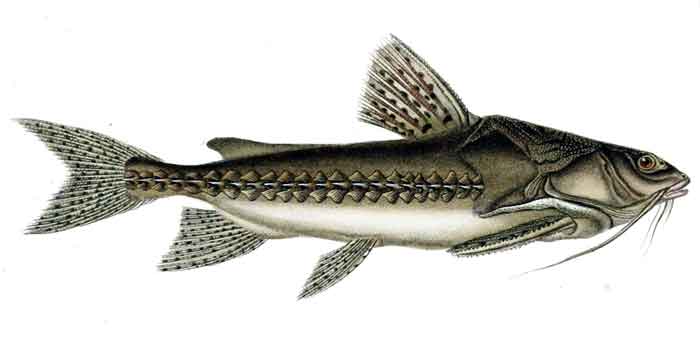
Superregnum: Eukaryota
Cladus: Unikonta
Cladus: Opisthokonta
Cladus: Holozoa
Regnum: Animalia
Subregnum: Eumetazoa
Cladus: Bilateria
Cladus: Nephrozoa
Superphylum: Deuterostomia
Phylum: Chordata
Subphylum: Vertebrata
Infraphylum: Gnathostomata
Megaclassis: Osteichthyes
Superclassis/Classis: Actinopterygii
Classis/Subclassis: Actinopteri
Subclassis/Infraclassis: Neopterygii
Infraclassis: Teleostei
Megacohors: Osteoglossocephalai
Supercohors: Clupeocephala
Cohors: Otomorpha
Subcohors: Ostariophysi
Sectio: Otophysa
Ordo: Siluriformes
Familia: Doradidae
Genus: Pterodoras
Species: Pterodoras granulosus
Name
Pterodoras granulosus (Humboldt and Valenciennes, 1821)
References
Pterodoras granulosus – Taxon details on Integrated Taxonomic Information System (ITIS).
Vernacular names
English: Granulated catfish
português: Armado

The granulated catfish (Pterodoras granulosus) is a species of thorny catfish found in the Paraná and Amazon basin as well as the coastal drainages of Suriname and Guyana. This species is commercially caught for human consumption as well as being displayed in public aquaria.[1]
Description
This species grows to a length of 70 centimetres (28 in) TL and to a weight of 6.5 kilograms (14 lb).[1] The colour pattern of these catfish varies depending upon the location that they originate from, though they are usually a muddy-brown colour with some darker spots over the body and fins. Adults are darker and the spotting fades from juvenile coloration. There are no scales, but the skin is thick and tough; also, 23–28 shallow lateral plates known as scutes are found along the length of the body. Their eyes are very small in comparison to the rest of the fish and they have three simple pairs of barbels. They have a deeply forked caudal fin, which also helps to distinguish this fish from other large Doradids.[2]
Ecology
P. granulosus occurs in small groups.[1]
P. granulosus is a nocturnal predator. It is an opportunistic omnivore with a wide food spectrum, consuming vascular plants, mollusks, and other food depending on their availability. It has been shown that this species feeds on an introduced species of bivalve, Corbicula fluminae, and may be able to act as a form of biological pest control.[3] There is evidence that P. granulosus may be important for seed dispersal as seeds have been found in their stomachs; seeds of the families Gramineae, Moraceae, and Polygonaceae are most often present in their stomachs.[4]
P. granulosus is a migratory species of catfish. From March to July, there is little migration and any movement is downstream. In August, the upstream migration begins, intensifying in October and peaking in January.[4]
References
Froese, Rainer; Pauly, Daniel (eds.). "Pterodoras granulosus". FishBase. December 2011 version.
"PlanetCatfish::Catfish of the Month::September 2002". PlanetCatfish.com. 2005-06-17. Retrieved 2007-06-21.
Gaspar da Luz, Karla Danielle; Fugi, Rosemara; Abujanra, Fabiane; Agostinho, Angelo Antonio (2002). "Alterations in the Pterodoras granulosus (Valenciennes, 1833) (Osteichthyes, Doradidae) diet due to the abundance variation of a bivalve invader species in the Itaipu Reservoir, Brazil" (PDF). Maringá. 24 (2): 427–432. Archived from the original (PDF) on 2007-09-29. Retrieved 2012-02-02.
de Souza-Stevaux, Maria Conceicao; Negrelle, Raquel R. B.; Citadini-Zanette, Vanilde (1994). "Seed Dispersal by the Fish Pterodoras granulosus in the Parana River Basin, Brazil". Journal of Tropical Ecology. 10 (4): 621–626. doi:10.1017/S0266467400008294. S2CID 86734274.
Retrieved from "http://en.wikipedia.org/"
All text is available under the terms of the GNU Free Documentation License

